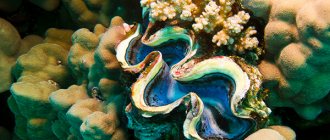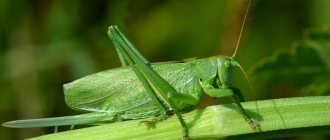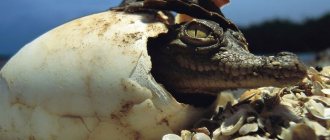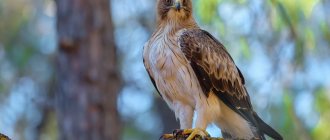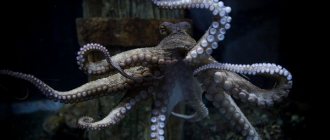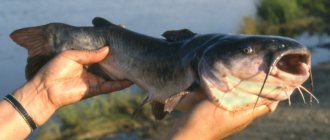In order to meet mysterious creatures, you don’t need to fly into space - just look at the bottom of the ocean.
It is there that an amazing animal lives, which has captivated the minds of sailors and travelers for centuries - and it is called the giant octopus. What kind of creature is this, and is its size really so impressive? Have you tried octopus?
- Yes 71%, 627 votes
627 votes 71%627 votes - 71% of all votes
- No 29%, 258 votes
258 votes 29%
258 votes - 29% of all votes
Total votes: 885
18.10.2019
- Yes 71%, 627 votes
627 votes 71%627 votes - 71% of all votes
- No 29%, 258 votes
258 votes 29%
258 votes - 29% of all votes
Total votes: 885
18.10.2019
×
You or from your IP have already voted.
The largest octopus in the world
The giant octopus, or another name - Doflein's octopus, is a cephalopod belonging to the genus Enteroctopus from the family Enteroctopodidae. Like all representatives of the species, these individuals have a specific appearance - a short circular body ending in long tentacles on which there are numerous suckers arranged in several rows. Each of them holds a weight of up to 100 grams, and in total there are about 900 of them on the 8 tentacles of the octopus. But, unlike its artificial counterpart, for their work the giant animal has to strain its muscles.
However, these large octopuses still have several special features that distinguish them from their relatives - their funnel organ is W-shaped, and their eyes are framed by skin outgrowths similar to horns.
These giant sea animals can quickly adapt to their environment - they change color depending on the environment, masquerading as a stone or rock. Thanks to the presence of three hearts and a special circulatory system, they can stay on land for several hours and move along the shore without harm to health.
Octopuses are among the most developed invertebrate animals and have the rudiments of a brain. That is, they have memory, are able to distinguish objects, tastes, sounds, as well as recognize people and show simple emotions. As a result of this, they respond well to training, and if you train them for a long time, they become tame.
One more feature
Giant octopuses have another distinctive feature - supraocular folds. These are 3-4 outgrowths, one of which is shaped like an ear. The octopus's mouth is located in the center of the ring formed by the upper ends of the legs; the mouth has a beak, very reminiscent of the inverted beak of a parrot, because the lower jaw extends beyond the upper. The age of an individual can be determined by its beak. In old octopuses it is dark brown in color, while in young octopuses it is transparent. With this hard tool, the cephalopod easily breaks through the shells of crabs and shells of mollusks. Octopuses have three hearts and blue blood. One heart of the underwater “aristocrat” circulates blood throughout the body, the other two push it through the gills, thanks to which the octopus breathes. But he can go without water for a decent amount of time.
How much does an octopus weigh?
Typically, the weight of giant cephalopods varies between 4 – 10 kg. There are also larger individuals, weighing from 30 to 50 kg and measuring from 150 cm to 300 cm, but they are rare. The largest specimen of such an octopus officially registered in the Guinness Book of Records weighed 58 kg and its length was 3.5 meters. This giant was caught off the coast of the United States in 1945 and filmed.
There are several references in the literature that back in the 19th century, people discovered a dead octopus on the coast of New Zealand, more than 9 meters long and weighing almost 200 kg. But this information has not been officially confirmed, despite numerous publications and photos.
Octopuses have well-developed sexual dimorphism, that is, females differ significantly from males. This also applies to size - female representatives are much larger than male representatives.
"Hands"
Giant octopuses (photo attached) look like this: they have a small soft body compared to the length of the tentacles (there are only eight of them, hence the name of the mollusk), the “arms” are connected to each other by short membranes, which are very elastic and can stretch to a transparent color. This allows the “arms” to be very mobile. Each tentacle has suckers arranged in two rows, ranging from 250 to 300 pieces each. One suction cup can support a weight of 100 grams.
Habitat
Giant clams prefer to live in cold water, so their habitat is limited to the cold waters of the seas and oceans. The optimal temperature for their life activity ranges from 5 to 12 °C.
They are characterized by seasonal migrations: in the summer, when the water warms up greatly, giant individuals sink to the bottom and dig out a wide lair from which they hunt. In autumn and winter they rise closer to the surface and settle in rocky soil.
Contrary to popular myths and sea stories, this giant sea creature is not found in the open ocean and deep bays. Octopuses prefer to live at shallow depths near underwater rocks, crevices or caves. That is why they are so often encountered by scuba divers and biologists who study this species and take numerous photos and videos.
Doflein's octopus is called the most studied representative of this species. Recently, scientists were able to decipher its genome, and found that it is 2.7 billion base pairs. This information will allow scientists to further understand how long it took this species to evolve this way.
Other zoological details
Some species of giant octopuses are not harmless. And it’s not about the scary pictures of malacologist (a scientist who studies mollusks and soft-bodied animals) Denis de Montfort. Blue-ringed octopuses with unusually toxic venom are found on the western Pacific coast.
It can be added to the description that on the tongue of these cephalopods there is a radula, or horny grater, consisting of seven rows of transverse teeth, the largest of which are located in the central row. But this is not an exhaustive description. It should be noted the extraordinary intelligence of these animals, which is equal to the intelligence of cats and dogs. The octopus also has skin whose cells are filled with multi-colored pigments, thanks to which the animal can change its color in just one second.
Octopus enemies
Despite their large size and predatory lifestyle, these giants have many enemies. They often become victims of halibut, sharks, sperm whales, seals and people.
Recently, large individuals have become rare, as their commercial catch has increased and they simply do not have time to reach sexual maturity and large sizes.
Octopuses reproduce only once in their lives - after laying eggs, the female octopus stops producing digestive enzymes, so she cannot feed and after a while dies from exhaustion, protecting her offspring. The male also dies, but much earlier - immediately after mating.
Angel of Death
The Apollyon octopus was named after the angel of the abyss and death. The mollusk received its far from harmless name for its ability to kill a victim with a stream of poison and suck out its flesh. He hunts mainly for crabs. If an apollyon bites a person, the symptoms will be the same as those of a snake bite, but they are not fatal. The swelling from the bite goes away in 2-3 weeks.
Octopus apollyon
It is known for certain that octopuses do not attack people; rather, they avoid meeting them. In most cases, all bites are self-defense.
Spreading
The largest octopus can be found in the northern waters of the Pacific Ocean - in the coastal zone of North America, from Baja California to Alaska in the northeast and Japan in the west. These marine inhabitants are also found in the Sea of Japan, Okhotsk and Bering Sea.
The distribution area of this large octopus is from the coast of Japan and the Korean Peninsula to Primorye and the southern part of Sakhalin Island, including Kamchatka, the Commander, Aleutian and Kuril Islands.
Now their numbers are noticeably declining. Scientists name several reasons for this phenomenon, among which humans, global warming and pollution of the world's oceans occupy a special place.
Wonders of nature
Sometimes the ocean threw the carcasses of sea monsters from its depths onto the shore. The most famous monster is one found on the shore on November 30, 1896 in the eastern part of the Florida peninsula. It was a gigantic creature with limbs up to 11 meters. The monster was photographed and some of its parts were preserved in alcohol, which made it possible to conduct research in 1957, 1971, and 1995. It was not possible to obtain specific data. But most scientists agree that the sea demon washed ashore on the Florida peninsula is most likely a giant octopus or squid. However, the literature says a lot about “real” encounters with sea monsters. There are websites with a special focus on the Internet for lovers of cannibalistic animals.
Economic importance
Pacific octopus is a favorite delicacy among residents of coastal countries, and Doflein's octopus is no exception. Due to its coastal habitat and large size, it is often targeted by divers and fishermen. In Japan, South Korea and North Korea, this giant sea creature is a game animal, so they are caught on a huge scale and exported to other countries.
Various dishes are prepared from octopuses - they are boiled, canned, fried, stewed with other seafood delicacies and dried. Not a single traditional oriental dish can do without this ingredient.
Krakens
The giant octopus krakens, known to everyone from the stories of Icelandic sailors, are more fictional than real creatures. The inhabitants of the “ice country”, who gave them this name, passed on the legends orally.
“Eyewitness accounts” of sea animals, which, due to their gigantic size, were mistaken for islands by sailors and fishermen, accumulated so much that Eric Ponntopidan (1698-1774), who was the Bishop of Bergen and an amateur naturalist, compiled a detailed summary of this peculiar sea folklore But the zoologist Pierre-Denis de Montfort, in love with everything fantastic, already mentioned above, described the mythical monster in a study published in 1802 and even classified it, giving it the name Kraken octopus. Scientists treated this ironically, and in the republished study the kraken was no longer mentioned.
Features of character and lifestyle
Photo: Sea octopus
Octopuses are dedicated loners, very attached to their territory. They lead a sluggish, sedentary lifestyle, running from place to place only when necessary: when there is not enough food in the old territory, when enemies have appeared around, or when they are looking for a partner.
Octopuses consider each other competitors, so one octopus tries to avoid the territory in which another octopus lives. If a collision does occur and the trespasser is in no hurry to leave, a fight may occur in which one octopus risks being injured or eaten. But such collisions are extremely rare.
During the day, octopuses hide in a shelter, and at night they go out into more open spaces to hunt. Octopuses like to choose various traces of human activity as a home: boxes, bottles, car tires, etc. They live in such houses for a long time. There is cleanliness around the octopus's house: they remove excess debris and dead algae, as if sweeping the surroundings with a stream of water. They put leftovers and garbage in a separate pile.
In the winter, octopuses descend to the depths, in the summer they live in shallow water, and they can sometimes be found on the shore - octopuses are often thrown out by waves.
